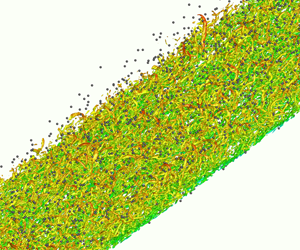Article contents
Eulerian–Lagrangian direct numerical simulation of preferential accumulation of inertial particles in a compressible turbulent boundary layer
Published online by Cambridge University Press: 22 September 2020
Abstract

In this study, direct numerical simulation of the dispersion and motion of inertial particles in a spatially developing compressible turbulent boundary layer at a Mach number of 2 is performed with the Eulerian–Lagrangian point particle method. Two cases are simulated with different particle diameters (Stokes number) but identical inflow particle numbers. Statistical characteristics and preferential accumulation of particles in the very-near-wall and wake regions are systematically investigated through conditional sampling and mechanism analysis. The results reveal that particle streaks are formed in low-speed regions near the wall because of the influence of dominating ejection events. After normalization with the local minimum particle number density, the particle number density profile reveals a self-similar feature at different streamwise positions. Compared with small particles, large particles are more significantly influenced by turbophoresis and demonstrate stronger preferential accumulation; thus, more large particles are clustered in the near-wall regions and the deviation between the mean velocities of the particle and the fluid increases. With the wall effect, both large and small particles are selectively accumulated in high-vorticity regions in the buffer layer in contrast to turbulence without walls. In comparison with incompressible wall-bounded turbulence, a new mechanism for particle preferential accumulation based on local fluid density is discovered. Large particles are located in low-density regions in the inner zones and high-density regions in the outer zones. Nevertheless, small particles remain located in regions with low fluid density, as illustrated by the mechanism analysis of particle dilatation.
- Type
- JFM Papers
- Information
- Copyright
- © The Author(s), 2020. Published by Cambridge University Press
References
- 18
- Cited by





